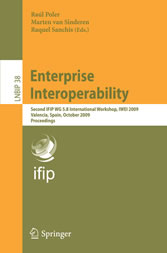Suchen und Finden
Mehr zum Inhalt

Enterprise Interoperability - Second IFIP WG 5.8 International Workshop, IWEI 2009, Valencia, Spain, October 13-14, 2009, Proceedings
Preface
5
Organization
7
Table of Contents
9
Full Papers
9
Towards Cross-Organizational Innovative Business Process Interoperability Services
11
Introduction
11
Related Work
12
Collaborative Business Process Interoperability
12
Top-Down Vertical Business Process Interoperability
13
Bottom-Up Vertical Business Process Interoperability
15
Towards EI Service Utilities
17
Ongoing Activities and Preliminary Results
19
Tooling: Research, Candidates and Evaluation in Respect to SaaS
19
Transformation from Private Process to View Process
20
CBPip Post-execution Analysis with CBPip Modeling
21
Conclusions and Future Work
21
BP Modeling Enhancement: Next Steps
21
Transformation into a View Process: Next Steps
22
CBPip Post-execution Analysis: Next Steps
22
References
22
Barriers to Enterprise Interoperability
23
Introduction
23
The Framework for Enterprise Interoperability
24
Identifying the Barriers to Interoperability
26
Conceptual Barriers
27
Technological Barriers
29
Organizational Barriers
30
Relationships between the Barriers
31
Conclusion
33
References
34
A SOA-Based Platform-Specific Framework for Context-Aware Mobile Applications
35
Introduction
35
Design Methodology
36
Reference Architecture
36
MDA-Based Methodology
38
Platform-Specific Framework
39
Case Study
42
Related Work
45
Conclusions and Future Work
45
References
46
An Ontological Solution to Support Interoperability in the Textile Industry
48
Introduction
48
Ontology Basic Concepts
49
Ontology Representation Formalisms
50
Ontology Development Methodologies
51
Enterprise Ontology Review
52
Enterprise Ontology Approaches
52
Case Study Context
53
About the Textile/Clothing Industry
53
Textile/Clothing Industry Interoperability Approaches Review
53
Development of an Ontology for the Textile/Clothing Industry
54
Determine the Domain, the Benefits and the Scope of the Ontology
55
Identification of Relevant Terms
56
Introduction of Basic Relationships between Terms
57
Design and Creation of the Required Application Axioms
58
Conclusions
59
References
59
An Approach towards Enterprise Interoperability Assessment
62
Introduction
62
Related Work
64
Outline of Paper
65
The Proposed Interoperability Assessment Method
65
Analytical Hierarchy Process (AHP)
66
Steps of the Proposed Approach
67
A Case Study Using the Method
70
Conclusion and Future Work
73
References
73
Classifying Enterprise Architecture Analysis Approaches
76
Introduction and Motivation
76
A Classification Schema for EA Analysis Approaches
78
State-of-the-Art in Enterprise Architecture Analysis
81
Conclusion and Outlook
85
References
87
Guiding the Service Engineering Process: The Importance of Service Aspects
90
Introduction
90
The Service Aspects
92
The Relevance of Cross-Organizational Collaboration
92
Increased Importance of the Identification of Stakeholders
93
The Need for Increased Effort at Run-/Change Time
94
Applying Service Aspects to a Concrete Methodology
94
The SeCSE Methodology
95
The SOSE Process Model for the SeCSE Methodology
95
Related Work
101
Conclusions
102
References
103
From Business Value Model to Coordination Process Model
104
Introduction
104
Related Work
105
Business Value Models and Coordination Process Models
106
Differences
107
Similarities
108
From a Value Model to a Coordination Model
109
Case Study
111
Value Model
111
Coordination Model
114
Analysis of Results
114
Conclusion and Future Work
115
References
116
Position Papers
9
SOP4EBPM: Generating Executable Business Services from Business Models
117
Introduction
117
REMPLANET Project
119
REMPLANET SOP4EBPM
119
Related Work
121
Conclusions
122
References
122
A Framework for a Decision Support System in a Hierarchical Extended Enterprise Decision Context
123
Introduction
123
Hierarchical Production Planning
124
Logical Constructs for Information and Decision Systems
124
A Framework for Decision Support Systems in Hierarchical Extended Enterprise Decision Making
125
Components
125
Relationships
127
Roles
129
DSS Platform
129
Interoperability Aspects
131
Conclusions
132
References
133
An Interoperability Architecture for Networked Service Delivery
135
Introduction
135
State of the Art
136
Service Composition
136
Service Provisioning
137
Service Quality
137
Components of the Service Architecture
138
Discussion of the Service Architecture
140
Conclusion
141
References
141
Author Index
143
Alle Preise verstehen sich inklusive der gesetzlichen MwSt.








